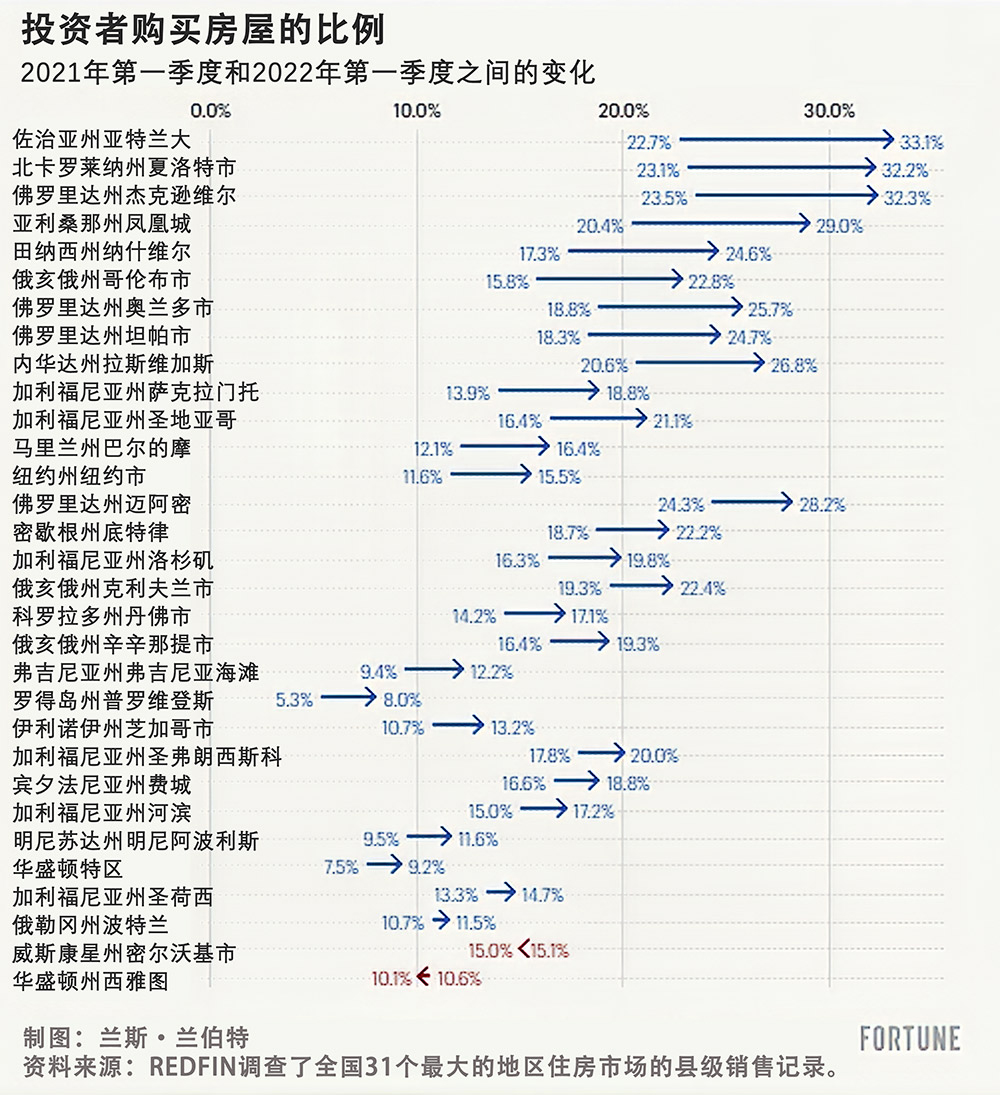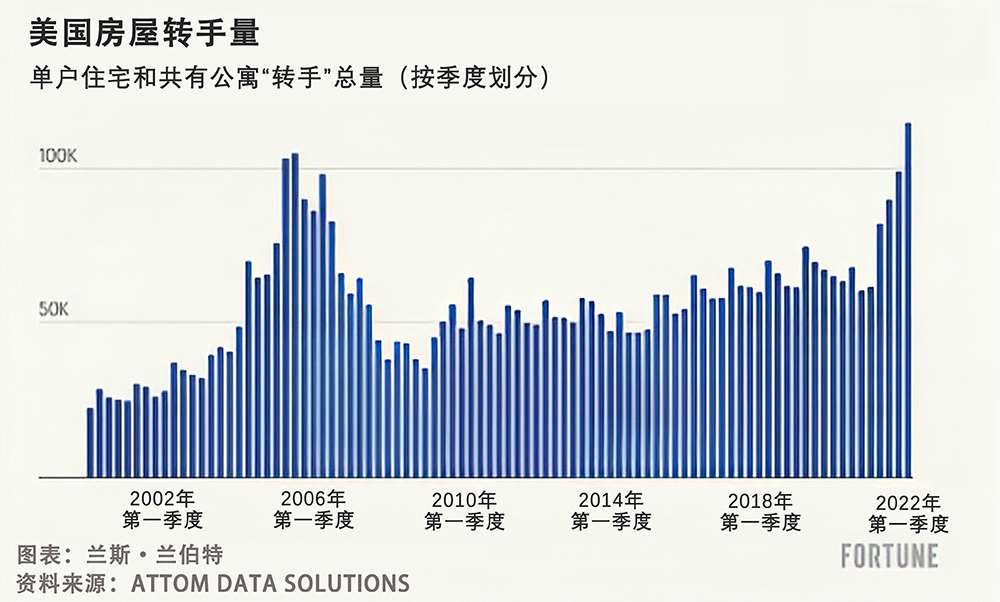
疫情時(shí)期的房地產(chǎn)熱潮引發(fā)了“投資者狂熱”,,這是自房地產(chǎn)泡沫以來美國房地產(chǎn)市場從未見過的,。普通人紛紛涌入市場,希望建立愛彼迎(Airbnb)帝國,。機(jī)構(gòu)投資者,,比如黑石集團(tuán)旗下的Home Partners of America,迅速擴(kuò)大了他們的單戶住宅投資組合,。房屋建筑商急于趁熱打鐵,,破土動(dòng)工建造創(chuàng)紀(jì)錄的“投機(jī)性”房屋。而像Opendoor和Zillow這樣的iBuyers(iBuyer模式的最大優(yōu)勢是簡化了房屋買賣的流程,,即房地產(chǎn)投資人直接從賣家手中買房,買家再向公司購房,,iBuyer公司承擔(dān)了其中的交易環(huán)節(jié))則優(yōu)化了購房算法,。
快進(jìn)到10月份,投資者狂熱已經(jīng)被投資者恐慌所取代,。美國正在進(jìn)行住房修正——房價(jià)在6月至8月間下降了1.6%,,這讓許多投資者望而卻步。這標(biāo)志著自2012年以來美國全國房價(jià)首次出現(xiàn)下跌,。
投資者的回撤是有道理的,。雖然大多數(shù)住房經(jīng)濟(jì)學(xué)家并不認(rèn)為會(huì)出現(xiàn)像金融危機(jī)那樣規(guī)模的房價(jià)修正——在金融危機(jī)期間,美國房價(jià)在2006年至2012年期間下跌了27%——但他們承認(rèn),,這次房價(jià)修正比2006年時(shí)更為劇烈,。滯后的凱斯-席勒指數(shù)(Case-Shiller Index)已經(jīng)顯示,,舊金山的房價(jià)下降了8.2%。
在Redfin首席執(zhí)行官格倫·凱爾曼看來,,疫情期間的房地產(chǎn)熱潮帶來的投資者狂熱可以用來解釋為什么這次房價(jià)回落速度更快,。從歷史上看,房價(jià)具有粘性,。賣家根本不想在價(jià)格上讓步,,除非經(jīng)濟(jì)因素,如供應(yīng)過剩,,迫使他們轉(zhuǎn)手,。但對于機(jī)構(gòu)投資者和建筑商來說,情況就不同了,。如果他們認(rèn)為價(jià)格即將下跌,,他們就會(huì)想先退出。凱爾曼說,,在疫情時(shí)期的房地產(chǎn)熱潮中,,投資者在購房者中所占比例上升,這最終使美國房地產(chǎn)市場更容易受到房價(jià)下滑的沖擊,。
“當(dāng)如雨后春筍般林立的摩天大樓出現(xiàn)問題時(shí),,你們(投資者)第一個(gè)想退出。要做到這一點(diǎn)就要找到最低銷售價(jià)格,,然后再降2%,。如果在第一個(gè)周末還沒有賣出去,就[繼續(xù)]降低銷售價(jià)格,?!眲P爾曼說。
換句話說,,凱爾曼暗示,,房地產(chǎn)投資者,包括Redfin的iBuyer業(yè)務(wù),,在經(jīng)濟(jì)繁榮時(shí)期推動(dòng)房價(jià)更快上漲,,并將在修正期間推動(dòng)房價(jià)更快回落。
“我的看法是,,由于建筑商和iBuyers占了更多庫存,,這導(dǎo)致了房價(jià)更快回落。我們就是其中之一,,我們也是iBuyer,。” 凱爾曼說,?!拔覀兞⒓醋⒁獾?,訪問我們網(wǎng)站的人越來越少,報(bào)名參觀房屋的人越來越少……我們坐擁價(jià)值3.5億美元的待售房屋,,這些房屋是我們用自己的錢買的,,或者更糟的是用貸款買的?!蔽覀円恢备嬖V投資者,,我們將通過迅速行動(dòng)來保護(hù)我們的資產(chǎn)負(fù)債表。我們沒有把希望作為一種策略,。我們立即開始降價(jià),。”

為什么疫情期間,,投資者紛紛涌入房地產(chǎn)市場(見上圖和下圖),?低抵押貸款利率、創(chuàng)紀(jì)錄的升值和飆升的租金結(jié)合起來,,讓投資者無法抗拒,。這吸引了從炒房者到房東夫妻,再到華爾街巨頭的所有人,。
但我們要清楚的是,,在疫情期間的房地產(chǎn)熱潮中,投資者狂熱并不足以讓美國房價(jià)上漲43%,。相反,,創(chuàng)紀(jì)錄的房價(jià)上漲是由一場完美風(fēng)暴引發(fā)的。白領(lǐng)專業(yè)人士可以在任何地方辦公,,他們既能購買更大的房產(chǎn),,也能前往博伊西這樣的遙遠(yuǎn)市場。抵押貸款利率在2021年1月跌至2.65%的歷史低點(diǎn),,即使在房價(jià)上漲的情況下,,也使得抵押貸款更容易負(fù)擔(dān)。更不用說,,這一切都發(fā)生在低庫存和有利的千禧一代首次購房者人口結(jié)構(gòu)時(shí)期,。

雖然抵押貸款利率的飆升導(dǎo)致了買方需求的歷史性回落,但這并沒有轉(zhuǎn)化為庫存的大幅飆升,。大多數(shù)房主并不害怕。那么,,在庫存水平緊張的情況下,,房價(jià)怎么會(huì)下跌呢?這是因?yàn)楦軛U投資者不想玩“觀望”的游戲,。而只要有一棟房子跌破其可比銷售價(jià)格,,就可以導(dǎo)致整個(gè)地區(qū)的可比銷售價(jià)格下降,。
“一旦需求減弱,我們就開始降低房價(jià),,這就推低了房價(jià),。在我們標(biāo)價(jià)降低的社區(qū)里,如今,,每一套待售房屋都會(huì)有可比銷售價(jià)格,,每個(gè)買家都會(huì)知道并談?wù)撨@一情況?!眲P爾曼說,。
當(dāng)然,在疫情期間的房地產(chǎn)熱潮中,,所謂的投資者狂熱并不是一成不變的,。投資者狂熱在鳳凰城、奧斯汀和拉斯維加斯等西部新興城市尤為瘋狂,。這可以用來解釋為什么那些充滿泡沫的房地產(chǎn)市場正在急劇修正,。
看看拉斯維加斯北部的這處房產(chǎn)就知道了。今年5月,,Opendoor以54.08萬美元的價(jià)格買下了這棟房子,。僅僅幾周后,Opendoor就在7月以58.1萬美元的價(jià)格將其掛牌出售,。但Opendoor為時(shí)已晚:拉斯維加斯的房地產(chǎn)市場已經(jīng)翻盤了,。時(shí)間快進(jìn)到10月,這套房源剛剛下架,,此前經(jīng)過一系列降價(jià),,其掛牌價(jià)已降至47.2萬美元。
乍一看,,人們可能會(huì)認(rèn)為Opendoor很快就會(huì)在這處房產(chǎn)上損失約13%,。并不完全是。當(dāng)Redfin和Opendoor等iBuyers購買房屋時(shí),,他們向賣家收取“服務(wù)費(fèi)”,,以換取快速交易。一方面,,這緩沖了iBuyer的潛在損失,。另一方面,這種緩沖意味著iBuyer不太害怕降價(jià),。
并不是所有人都同意凱爾曼的觀點(diǎn),。早在今年5月,Zillow的高管就曾對《財(cái)富》雜志表示,該公司失敗的iBuyer項(xiàng)目并沒有在疫情期間的房地產(chǎn)熱潮中推高美國房價(jià),。直到11月,,Zillow宣布將退出該項(xiàng)目,該項(xiàng)目以過高的價(jià)格購買房屋,,臭名昭著,。在Zillow看來,購買計(jì)劃規(guī)模太小,,根本無法推高美國房價(jià),。
雖然凱爾曼將抵押貸款利率上升帶來的房價(jià)迅速回落歸因于投資者和建筑商,但他表示,,還有其他因素在起作用,。他說,首先,,在2008年住房市場崩潰后的幾年里,,美國住房市場對抵押貸款利率變得更加敏感。其次,,他說,,房地產(chǎn)崩盤讓賣家和買家都知道,房價(jià)確實(shí)會(huì)下跌,。
“我認(rèn)為人們從1946年到2008年一直信奉的房價(jià)總會(huì)上漲的信仰已經(jīng)不復(fù)存在了,。我的父母認(rèn)為(房價(jià))下跌簡直是不可思議?!眲P爾曼說,。但他表示,2008年的房市崩盤打破了這種“信仰”,?!耙虼耍藗儯ìF(xiàn)在)對這種(修正)的反應(yīng)幾乎是創(chuàng)傷后應(yīng)激障礙(PTSD),,他們回撤得更快,。”
房價(jià)下一步將走向何方,?
房地美(Freddie Mac)和美國抵押貸款銀行家協(xié)會(huì)(Mortgage Bankers Association)等組織預(yù)計(jì),,未來幾年房價(jià)將出現(xiàn)橫盤走勢。穆迪分析公司和高盛等公司預(yù)測,,全國房價(jià)從峰值到低谷下跌了10%左右,。穆迪分析公司預(yù)測,如果經(jīng)濟(jì)衰退來襲,,全國房價(jià)的跌幅將在15%至20%之間,。簡而言之:出現(xiàn)了各種房價(jià)前景預(yù)測,。(財(cái)富中文網(wǎng))
譯者:中慧言-王芳
疫情時(shí)期的房地產(chǎn)熱潮引發(fā)了“投資者狂熱”,這是自房地產(chǎn)泡沫以來美國房地產(chǎn)市場從未見過的,。普通人紛紛涌入市場,希望建立愛彼迎(Airbnb)帝國,。機(jī)構(gòu)投資者,,比如黑石集團(tuán)旗下的Home Partners of America,迅速擴(kuò)大了他們的單戶住宅投資組合,。房屋建筑商急于趁熱打鐵,,破土動(dòng)工建造創(chuàng)紀(jì)錄的“投機(jī)性”房屋。而像Opendoor和Zillow這樣的iBuyers(iBuyer模式的最大優(yōu)勢是簡化了房屋買賣的流程,,即房地產(chǎn)投資人直接從賣家手中買房,,買家再向公司購房,iBuyer公司承擔(dān)了其中的交易環(huán)節(jié))則優(yōu)化了購房算法,。
快進(jìn)到10月份,,投資者狂熱已經(jīng)被投資者恐慌所取代。美國正在進(jìn)行住房修正——房價(jià)在6月至8月間下降了1.6%,,這讓許多投資者望而卻步,。這標(biāo)志著自2012年以來美國全國房價(jià)首次出現(xiàn)下跌。
投資者的回撤是有道理的,。雖然大多數(shù)住房經(jīng)濟(jì)學(xué)家并不認(rèn)為會(huì)出現(xiàn)像金融危機(jī)那樣規(guī)模的房價(jià)修正——在金融危機(jī)期間,,美國房價(jià)在2006年至2012年期間下跌了27%——但他們承認(rèn),這次房價(jià)修正比2006年時(shí)更為劇烈,。滯后的凱斯-席勒指數(shù)(Case-Shiller Index)已經(jīng)顯示,,舊金山的房價(jià)下降了8.2%。
在Redfin首席執(zhí)行官格倫·凱爾曼看來,,疫情期間的房地產(chǎn)熱潮帶來的投資者狂熱可以用來解釋為什么這次房價(jià)回落速度更快,。從歷史上看,房價(jià)具有粘性,。賣家根本不想在價(jià)格上讓步,,除非經(jīng)濟(jì)因素,如供應(yīng)過剩,,迫使他們轉(zhuǎn)手,。但對于機(jī)構(gòu)投資者和建筑商來說,情況就不同了,。如果他們認(rèn)為價(jià)格即將下跌,,他們就會(huì)想先退出。凱爾曼說,,在疫情時(shí)期的房地產(chǎn)熱潮中,,投資者在購房者中所占比例上升,這最終使美國房地產(chǎn)市場更容易受到房價(jià)下滑的沖擊。
“當(dāng)如雨后春筍般林立的摩天大樓出現(xiàn)問題時(shí),,你們(投資者)第一個(gè)想退出,。要做到這一點(diǎn)就要找到最低銷售價(jià)格,然后再降2%,。如果在第一個(gè)周末還沒有賣出去,,就[繼續(xù)]降低銷售價(jià)格?!眲P爾曼說,。
換句話說,凱爾曼暗示,,房地產(chǎn)投資者,,包括Redfin的iBuyer業(yè)務(wù),在經(jīng)濟(jì)繁榮時(shí)期推動(dòng)房價(jià)更快上漲,,并將在修正期間推動(dòng)房價(jià)更快回落,。
“我的看法是,由于建筑商和iBuyers占了更多庫存,,這導(dǎo)致了房價(jià)更快回落,。我們就是其中之一,我們也是iBuyer,?!?凱爾曼說?!拔覀兞⒓醋⒁獾?,訪問我們網(wǎng)站的人越來越少,報(bào)名參觀房屋的人越來越少……我們坐擁價(jià)值3.5億美元的待售房屋,,這些房屋是我們用自己的錢買的,,或者更糟的是用貸款買的?!蔽覀円恢备嬖V投資者,,我們將通過迅速行動(dòng)來保護(hù)我們的資產(chǎn)負(fù)債表。我們沒有把希望作為一種策略,。我們立即開始降價(jià),。”
為什么疫情期間,,投資者紛紛涌入房地產(chǎn)市場(見上圖和下圖),?低抵押貸款利率、創(chuàng)紀(jì)錄的升值和飆升的租金結(jié)合起來,,讓投資者無法抗拒,。這吸引了從炒房者到房東夫妻,,再到華爾街巨頭的所有人。
但我們要清楚的是,,在疫情期間的房地產(chǎn)熱潮中,,投資者狂熱并不足以讓美國房價(jià)上漲43%。相反,,創(chuàng)紀(jì)錄的房價(jià)上漲是由一場完美風(fēng)暴引發(fā)的,。白領(lǐng)專業(yè)人士可以在任何地方辦公,他們既能購買更大的房產(chǎn),,也能前往博伊西這樣的遙遠(yuǎn)市場。抵押貸款利率在2021年1月跌至2.65%的歷史低點(diǎn),,即使在房價(jià)上漲的情況下,,也使得抵押貸款更容易負(fù)擔(dān)。更不用說,,這一切都發(fā)生在低庫存和有利的千禧一代首次購房者人口結(jié)構(gòu)時(shí)期,。
雖然抵押貸款利率的飆升導(dǎo)致了買方需求的歷史性回落,但這并沒有轉(zhuǎn)化為庫存的大幅飆升,。大多數(shù)房主并不害怕,。那么,在庫存水平緊張的情況下,,房價(jià)怎么會(huì)下跌呢,?這是因?yàn)楦軛U投資者不想玩“觀望”的游戲。而只要有一棟房子跌破其可比銷售價(jià)格,,就可以導(dǎo)致整個(gè)地區(qū)的可比銷售價(jià)格下降,。
“一旦需求減弱,我們就開始降低房價(jià),,這就推低了房價(jià),。在我們標(biāo)價(jià)降低的社區(qū)里,如今,,每一套待售房屋都會(huì)有可比銷售價(jià)格,,每個(gè)買家都會(huì)知道并談?wù)撨@一情況?!眲P爾曼說,。
當(dāng)然,在疫情期間的房地產(chǎn)熱潮中,,所謂的投資者狂熱并不是一成不變的,。投資者狂熱在鳳凰城、奧斯汀和拉斯維加斯等西部新興城市尤為瘋狂,。這可以用來解釋為什么那些充滿泡沫的房地產(chǎn)市場正在急劇修正,。
看看拉斯維加斯北部的這處房產(chǎn)就知道了,。今年5月,Opendoor以54.08萬美元的價(jià)格買下了這棟房子,。僅僅幾周后,,Opendoor就在7月以58.1萬美元的價(jià)格將其掛牌出售。但Opendoor為時(shí)已晚:拉斯維加斯的房地產(chǎn)市場已經(jīng)翻盤了,。時(shí)間快進(jìn)到10月,,這套房源剛剛下架,此前經(jīng)過一系列降價(jià),,其掛牌價(jià)已降至47.2萬美元,。
乍一看,人們可能會(huì)認(rèn)為Opendoor很快就會(huì)在這處房產(chǎn)上損失約13%,。并不完全是,。當(dāng)Redfin和Opendoor等iBuyers購買房屋時(shí),他們向賣家收取“服務(wù)費(fèi)”,,以換取快速交易,。一方面,這緩沖了iBuyer的潛在損失,。另一方面,,這種緩沖意味著iBuyer不太害怕降價(jià)。
并不是所有人都同意凱爾曼的觀點(diǎn),。早在今年5月,,Zillow的高管就曾對《財(cái)富》雜志表示,該公司失敗的iBuyer項(xiàng)目并沒有在疫情期間的房地產(chǎn)熱潮中推高美國房價(jià),。直到11月,,Zillow宣布將退出該項(xiàng)目,該項(xiàng)目以過高的價(jià)格購買房屋,,臭名昭著,。在Zillow看來,購買計(jì)劃規(guī)模太小,,根本無法推高美國房價(jià),。
雖然凱爾曼將抵押貸款利率上升帶來的房價(jià)迅速回落歸因于投資者和建筑商,但他表示,,還有其他因素在起作用,。他說,首先,,在2008年住房市場崩潰后的幾年里,,美國住房市場對抵押貸款利率變得更加敏感。其次,,他說,,房地產(chǎn)崩盤讓賣家和買家都知道,,房價(jià)確實(shí)會(huì)下跌。
“我認(rèn)為人們從1946年到2008年一直信奉的房價(jià)總會(huì)上漲的信仰已經(jīng)不復(fù)存在了,。我的父母認(rèn)為(房價(jià))下跌簡直是不可思議,。”凱爾曼說,。但他表示,,2008年的房市崩盤打破了這種“信仰”?!耙虼?,人們(現(xiàn)在)對這種(修正)的反應(yīng)幾乎是創(chuàng)傷后應(yīng)激障礙(PTSD),他們回撤得更快,?!?/p>
房價(jià)下一步將走向何方?
房地美(Freddie Mac)和美國抵押貸款銀行家協(xié)會(huì)(Mortgage Bankers Association)等組織預(yù)計(jì),,未來幾年房價(jià)將出現(xiàn)橫盤走勢。穆迪分析公司和高盛等公司預(yù)測,,全國房價(jià)從峰值到低谷下跌了10%左右,。穆迪分析公司預(yù)測,如果經(jīng)濟(jì)衰退來襲,,全國房價(jià)的跌幅將在15%至20%之間,。簡而言之:出現(xiàn)了各種房價(jià)前景預(yù)測。(財(cái)富中文網(wǎng))
譯者:中慧言-王芳
The Pandemic Housing Boom unleashed an “investor mania” unlike anything seen in the U.S. housing market since the aughts housing bubble. Average Joes poured into the market in hopes of building Airbnb empires. Institutional investors, like Blackstone-owned Home Partners of America, quickly expanded their single-family home portfolios. Homebuilders, eager to strike while the irons were hot, broke ground on a record number of “spec” homes. While iBuyers, like Opendoor and Zillow, ramped up their algorithmic homebuying programs.
Fast-forward to October, and that investor mania has been replaced by investor panic. The ongoing housing correction—U.S. home prices have fallen 1.6% between June and August—has scared many investors to the sidelines. That marks the first national home price decline since 2012.
The investor pullback makes sense. While most housing economists don’t foresee a correction on scale with the Great Financial Crisis bust—during which U.S. home prices fell 27% between 2006 and 2012—they do acknowledge that this home price correction is sharper than it was in 2006. The lagged Case-Shiller Index already shows that home prices are down 8.2% in San Francisco.
To Redfin CEO Glenn Kelman, the Pandemic Housing Boom’s investor frenzy helps explain why home prices are correcting faster this time around. Historically speaking, home prices are sticky. Sellers simply don’t want to relent on price unless economics, like a supply glut, force their hand. That’s not as much the case for institutional investors and builders. If they think prices are about to drop, they want to get out first. The fact that the Pandemic Housing Boom saw investors become a higher share of buyers, Kelman says, ultimately makes the U.S. housing market more vulnerable to a faster swing down.
“When the shiitake mushrooms hit the fan, you [investors] want to get out first. The way to do that is to figure out where the lowest sale is, and be 2% below that. And if it doesn’t sell in the first weekend, move it down [again],” Kelman says.
In other words, Kelman is suggesting that real estate investors, including Redfin’s iBuyer business, helped drive home prices up faster during the boom and will push prices down faster during the correction.
“My take is that because builders and iBuyers account for more inventory, that leads to a faster correction. We’re one of them, we’re an iBuyer,” Kelman says. “We notice immediately when fewer people are on our website and fewer are signing up for tours…We’re sitting on $350 million worth of homes for sale that we bought with our own money, or worse bought with borrowed money. And what we always told investors is that we would protect our balance sheet by acting quickly. We don’t have hope as a strategy. We immediately started marking down things.”
Why was there an investor bull rush (see charts above and below) into the housing market during the pandemic? A combination of low mortgage rates, record appreciation, and soaring rents simply made it irresistible for investors. It brought out everyone from home flippers, to mom-and-pop landlords, to Wall Street juggernauts.
But let’s be clear: Investor mania alone didn’t send U.S. home prices up 43% during the Pandemic Housing Boom. Instead, record home price appreciation was spurred by a perfect storm. The ability to work from anywhere saw white-collar professionals both pony up for larger properties and take off for far-flung markets like Boise. And historically low mortgage rates, which bottomed out at 2.65% in January 2021, made mortgage payments more affordable even as prices rose. Not to mention this all occurred amid a period of low inventory and favorable first-time millennial homebuyer demographics.
While spiked mortgage rates have caused a historic pullback in buyer demand, it hasn’t translated into a massive inventory spike. Most homeowners aren’t scared. So how can home prices fall even if inventory levels are tight? It’s because leveraged investors don’t want to play the “wait and see” game. And all it takes is one home to fall below its comp price to reduce comps for an entire area.
“As soon as demand weakened, we were marking properties down, and that drives prices down. Every other home for sale in a neighborhood where we marked the listing down now has a comparable sale that every buyer is going to know about and talk about,” Kelman says.
Of course, so-called investor mania during the Pandemic Housing Boom wasn’t one-size-fits-all. The investor frenzy was particularly fierce in Western boomtowns like Phoenix, Austin, and Las Vegas. That helps explain why those frothy housing markets are correcting so dramatically right now.
Look no further than this property in North Las Vegas. In May, Opendoor bought the home for $540,800. Just weeks later, Opendoor listed it for sale in July at $581,000. But Opendoor was too late: The Las Vegas housing market had already rolled over. Fast-forward to October, and the listing just got taken off the market after a series of price cuts brought its list price to $472,000.
At first glance, one might assume Opendoor could soon take a loss of around 13% on the property. Not exactly. See, when iBuyers like Redfin and Opendoor buy a home, they charge sellers a “service fee” in exchange for the speedy transaction. On one hand, that buffers the potential loss for the iBuyer. On the other hand, that buffer means the iBuyer is less afraid to mark down the price.
Not everyone agrees with Kelman. Back in May, Zillow officials told Fortune that the company’s failed iBuyer program—which notoriously overpaid for homes until Zillow announced in November it would exit the program—didn’t drive up U.S. home prices during the Pandemic Housing Boom. In Zillow’s eyes, the buying program was simply too small to do so.
While Kelman attributes the swiftness of the home price correction that was brought on by rising mortgage rates to investors and builders, he says there were also other factors at play. For starters, he says the U.S. housing market has become more mortgage rate sensitive in the years following the 2008 housing crash. Second, he says the housing crash taught sellers and buyers alike that home prices can indeed fall.
“I think that the religion people had from 1946 to 2008, that housing prices always go up, is dead. My parents believed that it was literally inconceivable for [home] prices to go down,” Kelman says. But that housing “religion” got broken, he says, by the 2008 crash. “So folks respond [now] to that [correction] with almost PTSD, and they pull back much more quickly.”
Where will home prices head next?
Groups like Freddie Mac and the Mortgage Bankers Association foresee home prices going sideways in the coming years. And firms like Moody’s Analytics and Goldman Sachs predict a peak-to-trough national decline of around 10%. If a recession hits, Moody’s predicts that national decline would come in between 15% to 20%. Simply put: Home price outlooks are all over the place.






